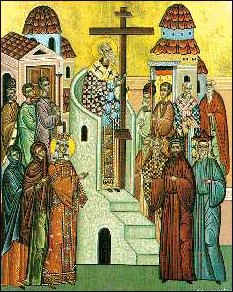



THE EXALTATION
OF THE CROSS
Midway through Great
Lent on the road to Paskha, the Eastern Church celebrates the feastday
of the Veneration of the Holy Cross. In his book, Great Lent - Journey
to Pascha, Orthodox theologian and writer, Father Alexander Schmemann,
quotes from the synaxarion of the day as follows: "On this Sunday, the
third Sunday of Lent, we celebrate the veneration of the honorable and
Life-Giving Cross.... the Life-Giving Cross is presented to us for refreshment
and assurance, for remembrance of our Lord's Passion, and for comfort....
Christ, who is about to show us His victory over death , and appear
to us in the glory of the Resurrection Day, is sending to us in advance
His scepter, the royal symbol - the Life-Giving Cross - and it fills
us with joy and makes us ready to meet .... the King Himself, and to
render glory to His victory ...." While the cross is the universal symbol
of Christians everywhere, it is perceived in the Eastern Church not
as a symbol of terror and punishment, or of lamentation and guilt, but
as an object of glory, a herald of the triumph of Christ over death
in the Glorious Resurrection. Thus in the kontakion of the Divine Liturgy
of the day, we sing: "No longer does the flaming sword guard the gates
of Eden; for on them one finds the most glorious seal, the Tree of the
Cross. By it the sorrow of death and the victory of the Abyss have been
conquered". When we chant the words: "We bow to Your Cross, O Lord,
and we praise Your Holy Resurrection", we reassert the faith of Eastern
Christians in the Holy Cross as Life-Giver and joyous prologue to the
Resurrection of Christ and through Him the resurrection of mankind. There is a much
legend and folk custom among Slavs which associates the willow as presage
of the Resurrection with the Life-Giving Cross. Crosses are made from
the branches of willows and used for many quasi-sacramental purposes
in the sanctification of daily life. Many of these customs or practices
will be illustrated in the texts contained in the Appendix. The practice
of making three-bar crosses out of willow branches has been largely
lost in North America. The material below is designed to assist in the
recovery of this custom. Among the many willow
customs of the Eastern Slavs is the crafting of three-bar crosses out
of willow branches to decorate the home and for personal devotions.
Pussy willows produce many upward growing branches during the period
of rapid growth in the summer. These may be cut with a sharp pruning
shears in mid-winter before the buds begin to swell, and cut into appropriate
segments to serve as the verticle beam and the three bars which characterize
the three-bar cross. For best results branches with a diameter greater
than that of a pencil should be taken. Green wood is soft and easily
worked. With a swope saw, cut halfway into the segment serving as the
verticle beam to create the grooves which will hold each of the bars
and remove the soft wood with a sharp knife. The sides and bottom of
the grooves should be flat. Do the same with the segments which will
serve as the bars, being careful to cut the lowest bar which serves
as the footrest at an angle so that the footrest will dip downward from
left to right. The grooves of all pieces should be filed smooth. Allow
the pieces to dry out for a few days. To secure the bars to the beam,
apply Probond Professional Strength Wood Glue to the grooves and fit
the pieces together to form the three-bar cross. In five minutes the
glue will harden enough to permit turning it over so that the three
bars rest directly on the table. At this point, check the beam and bars
to see that all are properly aligned. Place a heavy book or other weight
on the cross to hold the pieces tightly together while the glue hardens.
In a few hours the glue will harden enough to allow trimming the bars
and the verticle beam so that they appear properly. Then drill a small
hole through the top of the beam. Through the hole push a segment of
clear nylon fishing line and tie the ends into a knot. The cross may
then be hung on a small nail in the wall. Practice makes perfect and
after a few of such crosses are made, the maker may want to experiment
with making crosses of other sizes, large and small.
Return
to Index. |